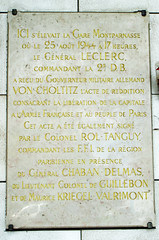General Dietrich von Choltitz
Commemorated on 2 plaques
Libération de Paris (15 août - 28 août 1944). Ce bâtiment, siège de la Préfecture de Police, a été, le samedi 19 août 1944, le lieu du déclenchement de l'insurrection des Parisiens contre l'armée d'occupation allemande à l'initiative des mouvements de résistance de la police. Pendant plusieurs jours, des combats meurtriers se déroulent autour de ce immeuble et dans les rues de Paris où policiers, sapeurs-pompiers et gardes républicains, avec leurs camarades FFI et FTP, combattent l'occupant. 167 policiers perdent la vie lors de ces combats. Alors que la révolte est au bord de l'asphyxie, un appel de la Résistance parisienne est lancé, dès le 23 août, auprès du commandement allié pour aider le soulèvement parisien. Sur ordre du général Eisenhower, commandant suprême des forces alliées, et à la demand expresse du général de Gaulle, le général Leclerc, commandant la 2ème DB, marche sur Paris. Le 24 août, il adresse un message, largué par avion, aux insurgés: "Tenez bon, nous arrivons". Dans la soirée du 24 août et au matin du 25 août, la 2ème DB entre dans Paris, le général Leclerc arrive à la Préfecture de Police déjà libérée. A 15 h 30, le général von Choltitz, commandant du "Gross Paris", se rend à la Préfecture de Police où il signe la convention de reddition des forces allemandes de Paris avec le général de division Leclerc en présence de MM. Chaban-Delmas, Rol-Tanguy et Kriegel-Valrimont, représentant la Résistance. Cet acte de capitulation est rendu public en fin d'après-midi à la gare Montparnasse devant une foule enthousiaste. Par leur action, leur courage et leur sacrifice, les hommes et les femmes de la Résistance ont facilité la progression des éléments de la 2ème DB et de la 4ème division d'infanterie américaine pour la libération de la Capitale.
English translation: Liberation of Paris (15 August - 28 August 1944). On August 19, 1944, this building, the seat of the Prefecture of Police, was the scene of the insurrection of the Parisians against the German occupation army at the initiative of the police resistance movements. For several days, murderous fights took place around this building and in the streets of Paris, where police, firefighters and Republican guards, with their FFI and FTP comrades, were fighting the occupiers. 167 policemen lost their lives during the fighting. As the revolt is on the brink of asphyxia, a call from the Parisian Resistance is launched, as of 23 August, with the allied command to help the Paris uprising. On the orders of General Eisenhower, the Supreme Commander of the Allied Forces, and at the express request of General de Gaulle, General Leclerc, commanding the 2nd Armored Division, marched on Paris. On August 24, he sent a message, dropped by air, to the insurgents: "Hold on, we come." On the evening of August 24th and the morning of August 25th, the 2nd DB entered Paris, General Leclerc arrived at the Prefecture of Police, already liberated. At 3:30 pm General von Choltitz, commander of the "Gross Paris", went to the Prefecture of Police where he signed the agreement of surrender of the German forces in Paris with Major General Leclerc in the presence of Messrs. Chaban-Delmas, Rol-Tanguy and Kriegel-Valrimont, representing the Resistance. This act of capitulation is made public at the end of the afternoon at Montparnasse station before an enthusiastic crowd. Through their action, courage and sacrifice, the men and women of the Resistance facilitated the advance of the elements of the 2nd DB and the 4th Infantry Division for the Liberation of the Capital.
9 Boulevard du Palais, Paris, France where they surrendered (1944)
Ici s'élevait la Gare Montparnasse où le 25 août 1944 à 17 heures, le Général Leclerc, commandant la 2e. D.B, a recu du Gouverneur militaire allemand Von Choltitz l'acte de reddition consacrant la libération de la capitale a l'Armée Française et au peuple de Paris. Cet acte a été également signé par le Colonel Rol-Tanguy, commandant les F.F.I. de la région parisienne en présence du Général Chaban-Delmas, du Lieutenant Colonel de Guillebon et de Maurice Kriegel Valrimont.
English translation: Here was the Gare Montparnasse where on August 25, 1944 at 5 pm, General Leclerc, commanding the 2nd. D.B, received from the German military governor Von Choltitz the act of surrender consecrating the liberation of the capital to the French army and the people of Paris. This act was also signed by Colonel Rol-Tanguy, commander of the F.F.I. of the Paris region in the presence of General Chaban-Delmas, Lieutenant Colonel de Guillebon and Maurice Kriegel Valrimont.
Gare Montparnasse, facing the rue de l'Arrivée, Paris, France where they was



